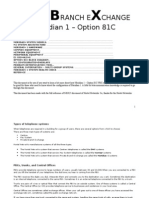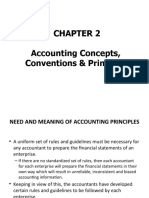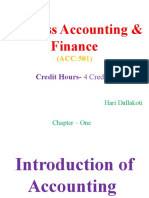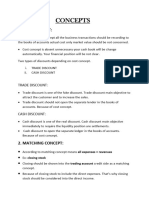0 ratings0% found this document useful (0 votes)
29 viewsAccounting Concepts and Conventions
The key accounting concepts are:
1) Business Entity, which treats a business as a separate legal entity from its owners.
2) Money Measurement, which records transactions in monetary terms rather than physical units.
3) Cost Concept, which records assets at their actual historical cost.
4) Going Concern, which assumes a business will continue indefinitely.
Uploaded by
Sheba Mary SamCopyright
© © All Rights Reserved
Available Formats
Download as PPTX, PDF, TXT or read online on Scribd
0 ratings0% found this document useful (0 votes)
29 viewsAccounting Concepts and Conventions
The key accounting concepts are:
1) Business Entity, which treats a business as a separate legal entity from its owners.
2) Money Measurement, which records transactions in monetary terms rather than physical units.
3) Cost Concept, which records assets at their actual historical cost.
4) Going Concern, which assumes a business will continue indefinitely.
Uploaded by
Sheba Mary SamCopyright
© © All Rights Reserved
Available Formats
Download as PPTX, PDF, TXT or read online on Scribd
You are on page 1/ 30
• Accounting concepts are basic assumptions or conditions
upon which the science of accounting is based.
1. Business Entity
2. Money Measurement
3. Cost Concept
4. Going Concern Concept
5. Dual Aspect Concept
6. Revenue Recognition Concept
7. Full Disclosure Concept
8. Accounting Period Concept
9. Matching Concept
Business Entity Concept
Business Entity Concept
• Treated as a separate legal person from its
owner
• Accounts are kept from the point of view of
business
• Capital is treated as a liability
Money Measurement Concept
Money Measurement Concept
• Only those transactions which can be expressed
in terms of money can be recorded.
• E.g. Sale of goods, Payment of wages etc.
• Qualitative aspects are not considered
• E.g. Appointment of manager, Creativity of
employees etc..
• Records of transactions are kept not in the
physical units but in monetary unit.
Money Measurement Concept
• Limitation – As the changes in the value of
money is not reflected in the books of
accounts, the accounting data does not reflect
the true and fair view of the business affairs.
Cost Concept
• Transactions are recorded on the basis of the
actual amount incurred at the time of its
acquisition.
• Eg; ABC ltd. Purchased a plant for Rs. 50 lakh
on 1st April 2005. An amount of Rs. 10000 was
spent for transportation, Rs. 20000 was spent
on its installation. Total amount recorded in
the books of accounts will be Rs.50,30,000/-
Cost Concept
• Cost Concept is historical in nature.
• Limitation : Does not show the true worth of
the business – hidden profits
Going Concern Concept
Going Concern Concept
• Business is assumed to have an indefinite life
• Basis for showing the value of assets in the
Balance Sheet.
• Eg; A purchased a personal computer for
Rs.50000 in 2021. It is not fair to charge the
whole amount of acquisition from the revenue
of the same year.
Dual Aspect Concept
• Foundation / basic principle of accounting
• Every transactions has two aspects;
Debit & Credit / Receiving & Giving aspect
• Double entry system
• Accounting Equation
Assets = Liabilities + capital
Realisation Concept
Revenue Recognition Concept
• Revenue of a business transaction is recorded
only when it is realized
• Eg; Credit sales are treated as revenue on the
day of sales itself not when the money is
received from the buyer.
• Expected incomes and gains are not recorded
• E.g. No entry for sales that will occur in future
Accounting Period Concept
• The whole indefinite life of the enterprise is
divided into parts known as the Accounting
Period.
• Normally consists of 12 months.
• Calendar year / financial year
Matching Concept
Matching Concept
• Expenses incurred in an accounting period
should be matched with revenues during that
period.
• To determine the profit earned or loss
suffered during the period.
• E.g. Adjustments like O/S expenses, accrued
income etc
Matching Concept
• All revenues earned during an accounting
period, whether received or not during that
year, and all costs incurred, whether paid
during the year or not, should be taken into
account while ascertaining the profit or loss
for that year.
Full Disclosure Concept
* All material and relevant facts regarding the
financial performance of a firm must be fully
and completely disclosed in financial statements
and their accompanying footnotes.
* Format prescribed by The Companies Act 1956
for the preparation of final accounts.
Accounting Conventions
• Customs or traditions which should be
followed while preparing the accounting
statements.
1. Consistency
2. Conservatism
3. Materiality
4. Objective Evidence
Consistency
• According to this assumption, business
practices once selected should be applied
consistently year after year
• Comparison of results
• Vertical, Horizontal and third dimensional
Consistency.
Conservatism
• To anticipate no profits and provide for all
losses
• Also known as prudence
• Safe guard against all possible losses in this
uncertain world.
• E.g. Stock is valued at market price of cost
price whichever is lower.
Materiality
• Report only what is material and ignore
insignificant details.
• Helps to avoid over burden with minute
details
• E.g. Pencils, pen, erasers etc are not shown as
assets
Objective Evidence Concept
• Every transaction should be supported by
verifiable documents or vouchers.
• Future reference
• Tax and legal purposes
You might also like
- Basics Configuration of PBX - Nortel Meridain 81c100% (4)Basics Configuration of PBX - Nortel Meridain 81c26 pages
- Basic Concepts and Fundamental Assumptions of AccountancyNo ratings yetBasic Concepts and Fundamental Assumptions of Accountancy11 pages
- Accounting Concepts, Conventions & PrinciplesNo ratings yetAccounting Concepts, Conventions & Principles34 pages
- CH 2 - Accounting Concepts and ConventionsNo ratings yetCH 2 - Accounting Concepts and Conventions43 pages
- Principle of Accounting - Bachelor 1 Updated Latest (Autosaved)No ratings yetPrinciple of Accounting - Bachelor 1 Updated Latest (Autosaved)58 pages
- Generally Accepted Accounting Principles GAAP12No ratings yetGenerally Accepted Accounting Principles GAAP129 pages
- Accounting Principle, Concepts, AssumptionNo ratings yetAccounting Principle, Concepts, Assumption29 pages
- CLASS XI Accountancy Chapter 2 Theory base of accountingNo ratings yetCLASS XI Accountancy Chapter 2 Theory base of accounting10 pages
- Module%202-Varied%20accounting%20concepts%20&%20principlesNo ratings yetModule%202-Varied%20accounting%20concepts%20&%20principles41 pages
- Topic 3 Accounting Concepts and PrinciplesNo ratings yetTopic 3 Accounting Concepts and Principles6 pages
- Accounting For Manager: Accounting Period April and Ends On 31 March Every Year Unless Otherwise Specifically MentionedNo ratings yetAccounting For Manager: Accounting Period April and Ends On 31 March Every Year Unless Otherwise Specifically Mentioned66 pages
- Accounting Concepts: They Are Useful in Preparing Financial Statements100% (1)Accounting Concepts: They Are Useful in Preparing Financial Statements9 pages
- Your Amazing Itty Bitty(R) Personal Bookkeeping BookFrom EverandYour Amazing Itty Bitty(R) Personal Bookkeeping BookNo ratings yet
- 3.4. Estimation of Evaporation: A Mmhg. Evaporation ENo ratings yet3.4. Estimation of Evaporation: A Mmhg. Evaporation E7 pages
- Lesson 5: Introducing Yourself : Yeray Vladimir Gonzalez SilvaNo ratings yetLesson 5: Introducing Yourself : Yeray Vladimir Gonzalez Silva20 pages
- 22 - AE - 111 - Module - 3 - Recording - Business - TransactionsNo ratings yet22 - AE - 111 - Module - 3 - Recording - Business - Transactions23 pages
- Sub: Risk Assumption Letter: Insured & Vehicle DetailsNo ratings yetSub: Risk Assumption Letter: Insured & Vehicle Details3 pages
- Lecture 3 - Bohr Models - Success and Its FailureNo ratings yetLecture 3 - Bohr Models - Success and Its Failure31 pages
- Critical Success Factors in Projects PinNo ratings yetCritical Success Factors in Projects Pin20 pages
- Umali V JBC July 25, 2017 G.R. No. 228628 Velasco, JR., J. FactsNo ratings yetUmali V JBC July 25, 2017 G.R. No. 228628 Velasco, JR., J. Facts1 page
- Tracer Study of Maritime Graduates of One Private Academic Institution in The Philippines From 2012-2017No ratings yetTracer Study of Maritime Graduates of One Private Academic Institution in The Philippines From 2012-201712 pages
- Budapest Ceenet 2001 - Satellite CommunicationsNo ratings yetBudapest Ceenet 2001 - Satellite Communications93 pages
- Basic Concepts and Fundamental Assumptions of AccountancyBasic Concepts and Fundamental Assumptions of Accountancy
- Principle of Accounting - Bachelor 1 Updated Latest (Autosaved)Principle of Accounting - Bachelor 1 Updated Latest (Autosaved)
- CLASS XI Accountancy Chapter 2 Theory base of accountingCLASS XI Accountancy Chapter 2 Theory base of accounting
- Module%202-Varied%20accounting%20concepts%20&%20principlesModule%202-Varied%20accounting%20concepts%20&%20principles
- Accounting For Manager: Accounting Period April and Ends On 31 March Every Year Unless Otherwise Specifically MentionedAccounting For Manager: Accounting Period April and Ends On 31 March Every Year Unless Otherwise Specifically Mentioned
- Accounting Concepts: They Are Useful in Preparing Financial StatementsAccounting Concepts: They Are Useful in Preparing Financial Statements
- Your Amazing Itty Bitty(R) Personal Bookkeeping BookFrom EverandYour Amazing Itty Bitty(R) Personal Bookkeeping Book
- 3.4. Estimation of Evaporation: A Mmhg. Evaporation E3.4. Estimation of Evaporation: A Mmhg. Evaporation E
- Lesson 5: Introducing Yourself : Yeray Vladimir Gonzalez SilvaLesson 5: Introducing Yourself : Yeray Vladimir Gonzalez Silva
- 22 - AE - 111 - Module - 3 - Recording - Business - Transactions22 - AE - 111 - Module - 3 - Recording - Business - Transactions
- Sub: Risk Assumption Letter: Insured & Vehicle DetailsSub: Risk Assumption Letter: Insured & Vehicle Details
- Umali V JBC July 25, 2017 G.R. No. 228628 Velasco, JR., J. FactsUmali V JBC July 25, 2017 G.R. No. 228628 Velasco, JR., J. Facts
- Tracer Study of Maritime Graduates of One Private Academic Institution in The Philippines From 2012-2017Tracer Study of Maritime Graduates of One Private Academic Institution in The Philippines From 2012-2017

























































































